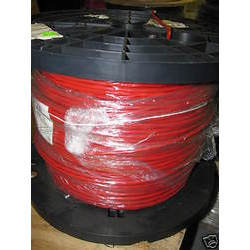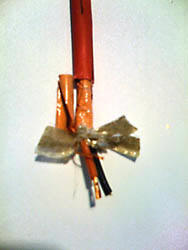 CI lost its UL 2196 listing in September 2012, so any installation that calls for a UL listed two hour survivability rating can’t use CI cable manufactured after then. UL states that CI cable manufactured before then was made to standards appropriate at the time so they recommend that any projects that are under way or are completed in design be reviewed with the AHJ regarding its use. As of 11/19/12, there’s nothing currently published that specifically prohibits the use of the CI cable in required installations in Chicago, but the Chicago Building Code [18-27-760.71(g)] cites UL 2196 as a method of determining a cable’s rating.
CI lost its UL 2196 listing in September 2012, so any installation that calls for a UL listed two hour survivability rating can’t use CI cable manufactured after then. UL states that CI cable manufactured before then was made to standards appropriate at the time so they recommend that any projects that are under way or are completed in design be reviewed with the AHJ regarding its use. As of 11/19/12, there’s nothing currently published that specifically prohibits the use of the CI cable in required installations in Chicago, but the Chicago Building Code [18-27-760.71(g)] cites UL 2196 as a method of determining a cable’s rating.
While recently speaking with an electrical design reviewer at the Chicago Department of Construction and Permitting (DCAP), we verified what we already thought to be true…They are not approving anything that UL has disavowed. There are only three ways to attain a 2 hour rating in Chicago:
1. Circuit pathways in areas constructed with a two hour rating.
2. Electrical protective systems with a UL 1724 listing. Electrical Circuit Protective Systems (FHIT) that employ protective materials such as intumescent wraps/coatings wraps, tapes, composite mats, etc., still continue to meet certification and code requirements.
3. Pathways embedded in 2″ of concrete surrounding it. Supports for the concrete must be rated as well.
 In one page announcements to their customers, cable manufacturers offer no direct replacement options, just a statement that the cable is no longer UL listed. Since new standards haven’t been published, UL is offering a program in which manufacturers can resubmit products for an interim marking based on what they think will meet the new survivability requirements, but should the standard come out differently than what they predicted, the submitted product will lose its marking once the new standard is published.
In one page announcements to their customers, cable manufacturers offer no direct replacement options, just a statement that the cable is no longer UL listed. Since new standards haven’t been published, UL is offering a program in which manufacturers can resubmit products for an interim marking based on what they think will meet the new survivability requirements, but should the standard come out differently than what they predicted, the submitted product will lose its marking once the new standard is published.
Here at Affiliated Customer Service, we don’t think any manufacturer is going to bear the cost of an interim re-designed cable and it’s evaluation cost & timeline, just to have it yanked when the new standard is in place. The bottom line is some municipalities may be more accommodating regarding survivability requirements with some front end demonstration of applicability & viability, but alternative methods of obtaining two hour survivability requirements are going to be used for a while in Chicago.

Circuit Integrity Durasystems Test
UPDATE: As of December 21, 2012, UL and ULC have re-established certification of Fire Resistive Cables for use in Electrical Circuit Integrity Systems. Please click on the following links and then click on “view listings” to see the specific manufacturers and systems covered by UL:
For installation in accordance with the National Electrical Code
oElectrical Circuit Integrity Systems (FHIT) http://database.ul.com/cgi-bin/XYV/t…604&sequence=1
oFire-resistive Cable (FHJR) http://database.ul.com/cgi-bin/XYV/t…610&sequence=1
This re-established MI cable as an option to obtain a two hour rating. If you would like more information or have questions, please feel free to contact us at 630-434-7900. Or leave us a comment below and we will get back to you shortly.


I have to provide a 2 hour rated riser for a fire alarm system in a hi rise. What are my options. I can’t do concrete. Please explain the other options. I understand they are some type of wrapped conduit and cable assembly or MI Cable???? I need help please explain.
For alarm fire systems and communication our system 1850 twisted pair shielded or nonshield is approved without limitation or special permission by the City of Chicago code 760.82 exception 2. The cable is about the thickness of a number 2 pencil. It is about as difficult to install as a piece of conduit. I can stop in and show you a sample.
Hi Ben,
I’ve had a number of designers of record & electrical contractors ask me this question recently. If you have an opportunity to stop by our office with a sample, I could pass your information on to those that need a similar solution. Contact me via email or phone at your convenience. Thanks!
Gene
Hello Ben,
I have a retrofit fire alarm installation calling for 2 hour risers. I have a/c closets that I will be running my verticals through. These a/c closets are open to the apartment ceilings. Not sure what if any fire rating this provides. What cable options do I have. What is 1850 twisted pair?
Hi Gene,
Just wondering if the MI cable must be installed in conduit for Chicago code requirements. The UL data show cable being installed bare no conduit.
Hi Tom,
Given its size and makeup, MI generally isn’t installed in conduit. However, it’s not specifically prohibited by the manufacturer nor the NEC, so without any other action, the city would flag any exposed fire alarm conductors. However, if it were me, I’d seek an exception from the Department of Construction and Permits (DCAP) by proposing a valid cable support system along with appropriate fire stopping techniques. So long as your alternate addresses the intent of survivability and smoke/fire containment (don’t use a polymer jacketed MI cable), you have a good chance of a variance, given the impracticality of pulling MI through conduit. MI generally has an overall diameter of about 7 mm (1/4 inch). Hope this helps!
Gene
Great. I’ll check in with DCAP.
What is an alternate to MI cable in the city? What are contractors using in lieu of CI?
Yes, I am told MI is very expensive and difficult to install. I see in the UL that it is run exposed on unistrut with steel or on concrete with a strap.
http://database.ul.com/cgi-bin/XYV/template/LISEXT/1FRAME/showpage.html?name=FHIT.1850&ccnshorttitle=Electrical+Circuit+Integrity+Systems&objid=1082893637&cfgid=1073741824&version=versionless&parent_id=1073986604&sequence=1
Also, what is polymer jacketed? Doesn’t achieve 2 hr rating?
For vertical two hour risers, most installers run FPL cable in conduit using an existing two hour enclosure (electrical room, mechanical room, stairwell). If you want to use the stairwells, ensure the egress path isn’t reduced or that other building services aren’t disrupted by coring. For the two hour horizontal risers that I’ve seen, installers have bitten the bullet and used MI, as the only other practical choices were to build a soffit or use a wrap system. They were granted a variance regarding conduit. Given the cost of MI cable, the soffit might be an option if it’s below ceiling and the owner’s OK with the appearance. You could also encase it in two inches of concrete if it’s a new building. Not too many go that way.
A polymer coating on an MI cable does not meet the UL two hour standard. If you get the copper sheathed MI cable, you’ll be good to go. Be sure the submitted data sheet highlights the copper sheathed part number.
Gene
I’m a local emplyee of Pentair and recently met with a group of Chicago electrical inspectors, they pointed out Chicago code 760.82 exception 2, MI does not have to go in conduit. The UL testing was done without conduit so the UL listing is without conduit as well.
Hi Ben,
Thanks for your input and for keeping us up to speed. For those that want to look at the code exception verbiage, Article 760.82 is listed in the Chicago Building Code as 18-27-760.82(a). It’s also a good reminder that if codes don’t address an installation issue (or even if it does), the manufacturer’s data sheet provides installation requirements that must be met as well.
Gene